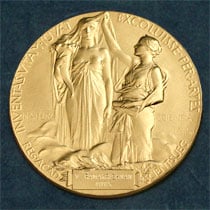
The medal of The Royal Swedish Academy of Sciences represents Nature in the form of a goddess resembling Isis, emerging from the clouds and holding in her arms a cornucopia. The veil which covers her cold and austere face is held up by the Genius of Science.
The inscription on the medal reads:
Inventas vitam iuvat excoluisse per artes
The words on the medal mean literally: It is beneficial to have improved (human) life through discovered arts.
These words are adapted from Vergil’s Aeneid, book 6, line 663,
inventas aut qui vitam excoluere per artes
There the hero Aeneas is in the underworld and looking upon the spirits of past human beings who made great contributions to the betterment of humankind by their unique creations and discoveries in what we now call artes et scientiae, the arts and sciences.
The original line was ably rendered by William Morris in 1876 as follows:
and they who bettered life on earth by new-found mastery
The name of the Nobel Prize laureate is engraved on the plate below the figures, and the text “REG. ACAD. SCIENT. SUEC.” stands for The Royal Swedish Academy of Sciences.
The Nobel Prize medals in physics and chemistry was designed by Erik Lindberg.
Since 2012 the Nobel Prize medals has been manufactured by Svenska Medalj in Eskilstuna.
More on the Nobel Prize medals and the medal for economic sciences:
Physics and chemistry
Physiology or medicine
Literature
Peace
Economic sciences